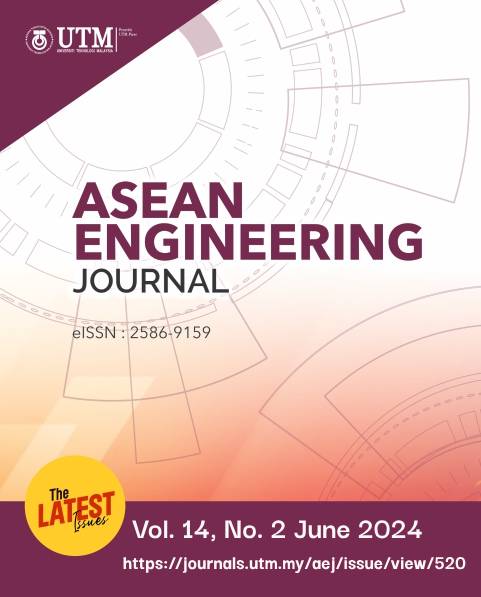VALIDATION OF THE HULL GIRDER DEFLECTION OF A MULTIPURPOSE CARGO SHIP
DOI:
https://doi.org/10.11113/aej.v14.21054Keywords:
Keywords: Analytical, numerical, hull girder, deflection, simply supported beamAbstract
When a ship encounters head-sea conditions, it can experience still water bending and wave-induced vertical moments. These moments can cause the hull girder to undergo longitudinal deflection, which can negatively impact the shaft alignment of the propulsion unit and the sealing of hatch covers and other onboard machinery. On the other hand, beam sea conditions can lead to transverse hull girder deflection, which is especially problematic for open-deck ships and can cause significant hatch-coming deflection. A numerical strength check has been performed using FEA software FEMAP with NX Nastran and an analytical review based on Euler-Bernoulli's beam theory to analyse the ship's strength. The ship is represented as a simply supported beam, and both analytical and numerical methods are used to calculate deflection for different sea conditions (head and beam seas). A mesh sensitivity analysis has been done to ensure the accuracy of the numerical analysis, and the results from both techniques are compared to validate their accuracy. Finally, a numerical analysis is conducted to confirm the accuracy of the analytical study when considering the ship as a complex structure. Overall, this research underscores the greater significance of longitudinal deflection over transverse deflection in the hull girder of a multipurpose cargo ship. Combining both approaches, a comprehensive understanding of the ship's hull girder strength and deflection behaviour is achieved, enhancing overall structural integrity and safety.
References
Crudu, L., O. Neculet, and O. Marcu. 2018. Hull deflection in still water and in waves of a pipe layer barge. in IOP Conference Series: Materials Science and Engineering. IOP Publishing, 2018: 062002. https://doi.org/10.1088/1757-899X/444/6/062002
Bai, Y., E. Bendiksen, and P.T. Pedersen, 1993. Collapase analysis of ship hulls. Marine Structures, 6(5-6): 485-507. https://doi.org/10.1016/0951-8339(93)90034-Z
Torralba Ben Amar, D.E., 2015. Analytical and numerical determination of the hull girder deflection of inland navigation vessels.
Ziha, K., 2002. Displacement of a deflected ship hull. Marine Technology and SNAME News, 39(01): 54-61. https://doi.org/10.5957/mt1.2002.39.1.54
Mennitt, S.H., 1990. The effects of shipload variations and sea state on hull girder deflection and combat system alignment [manuscript].
Lee, Y.-J., U.-K. Kim, and J.-S. Kim, 2006. Hull deflections affecting the ship's propulsion shafting alignment in 46K oil/chemical carrier. Journal of Advanced Marine Engineering and Technology, 30(7): 800-807.
Okumoto, Y., et al., 2009. Design of ship hull structures: a practical guide for engineers. Springer Science & Business Media. https://doi.org/10.1007/978-3-540-88445-3
Niebylski, J., 1970. Methods of evaluation of global and local ship hull deflections based on periodic geodesic measurements assuming a linear model of deflections. WIT Transactions on The Built Environment, 12.
Antoniou, A., 1980. On the maximum deflection of plating in newly built ships. Journal of Ship Research, 24(01): 31-39. https://doi.org/10.5957/jsr.1980.24.1.31
Lee, Y.-J. and U.-K. Kim, 2005. A study on hull deflection and shaft alignment interaction in VLCC. Journal of Advanced Marine Engineering and Technology, 29(7): 785-794.
Šverko, D., 2005. Investigation on hull deflection and its influence on propulsion shaft alignment. In SNAME Maritime Convention. OnePetro. https://doi.org/10.5957/SMC-2005-D27
Naar, H., 2006. Ultimate strength of hull girder for passenger ships. Helsinki University of Technology.
Α. Dardamanis, 2022. Development of model for the calculation of ship hull deflection, with application to the optimal alignment of propulsion shafting system. National Technical University of Athens.
Freire Duenas, W.T. and G. Winklemann de la Cruz, 1954. The effect of initial deflection on the stress distribution in a panel of plating of a ship under tensile load. Massachusetts Institute of Technology.
Okumoto, Y., et al., 2009. Deflection of Hull Structures, in Design of Ship Hull Structures: A Practical Guide for Engineers. Springer. 285-296. https://doi.org/10.1007/978-3-540-88445-3_15
Farias, M. dos Reis, L.A. Vaz, A.C.R. Troyman, and L.A.R. Baptista, 2023. Optimization of Shafting Alignment in Medium-Sized Vessels Considering Hull Deflection. Ocean Engineering.
Zhou, W., Y. Zhao, H. Yuan, and X. Wang, 2023. Study of the hull structural deformation calculation using the matrix displacement method and its influence on the shaft alignment. Journal of Marine Science and Engineering, 11(8). https://doi.org/10.3390/jmse11081495
Rigo, P. and E. Rizzuto, 2003. Analysis and design of ship structure. Ship Design and Construction, 1: 18-1.
Shama, M., 2012. Buckling of ship structures. Springer Science & Business Media. https://doi.org/10.1007/978-3-642-17961-7
Wang, X. and T. Moan, 1996. Stochastic and deterministic combinations of still water and wave bending moments in ships. Marine Structures, 9(8): 787-810. https://doi.org/10.1016/0951-8339(95)00022-4
Veritas, B., 2018. NR 467 Rules for the Classification of Steel Ships. Paris, France.
Chen, Z., et al., 2019. Numerical and experimental analysis of hydroelastic responses of a high-speed trimaran in oblique irregular waves. International Journal of Naval Architecture and Ocean Engineering, 11(1): 409-421. https://doi.org/10.1016/j.ijnaoe.2018.07.006
Ahmed, F., 2017. Development of guidelines allowing to predict the contribution of the superstructure to the hull girder strength.
Brassey, C.A., et al., 2013. Finite element modelling versus classic beam theory: comparing methods for stress estimation in a morphologically diverse sample of vertebrate long bones. Journal of the Royal Society Interface, 10(79): 20120823. https://doi.org/10.1098/rsif.2012.0823
















